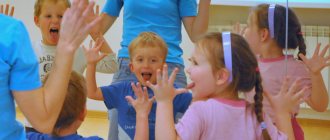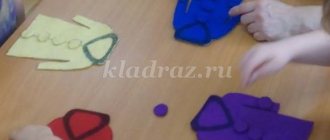“Card index of games for the development of fine motor skills in children of primary preschool age”
Card index of games for the development of fine motor skills
Educator: Zubkova L.V.
“Rolling on the table, between the palms of pencils and balls”
Goal: develop fine motor skills.
Children are given faceted pencils. The child places the pencil between the palms and rotates it, moving it from the base of the palms to the tips of the fingers. “Games with plasticine”
Learn to roll “balls and sausages” between your palms, develop the ability to cut small pieces from a large piece in a stack.
Form coordination of movements, develop the ability to regulate the force of pressing on the stack, hold it correctly, and develop imagination. “Find your soulmate”
- cut-out pictures.
Learn to identify parts of an object and connect them into a whole, develop visual orientation and fine motor skills. “Laces”
- teach how to put a lace in a hole.
Learn to thread a lace into a hole by imitation, model, develop purposefulness of actions and fine motor skills. “Puzzles”
This is a picture puzzle that must be assembled from individual pieces.
Puzzles come in wood, cardboard, foam rubber and plastic. You need to start with simple puzzles, consisting of two to four parts, each of which depicts a recognizable part (leg, head, paw, half of a boat, plane, ball, etc. “Games with beads”
Equipment: beads, strings. String beads on strings, making a decoration for the game. We string the beads in a certain order, alternating in shape, color, or size.
“Working with mosaics”
Equipment: mosaics of various types, samples of laid out figures. Lay out several rows of plates of the same color. Lay out a drawing from mosaics, having a sample in front of your eyes. Make up your own drawing based on past experience.
“Games with a constructor"
A constructor is a universal educational game. For kids, wooden and plastic construction sets are suitable, with small parts that are convenient to hold in your hands and overlap or connect to each other with a friend.
“Games-with-magnets”
Games with magnets for children of the second year of life mainly come down to attaching figures on magnets to different surfaces: a refrigerator, a magnetic board, metal objects (a mug, a battery, a pan, etc.) or to each other.
“Games with clothespins”
We attach clothespins to various objects: to a plastic bucket, to a wooden stick, to a book, to cardboard silhouettes (hedgehog, sun, flower, Christmas tree, etc.), to rope, to fabric, etc.
“Games with paper and napkins”
Paper snowballs: Show your child how to crumple a piece of paper (or a napkin) to make a snowball.
Paper snowflakes: Invite your child to tear a sheet of white paper (or a napkin) into small pieces - these will be snowflakes. Secrets: Wrap a toy in wrapping paper or foil and invite your child to unwrap the gift. “Finger pool”
The child puts his hands into a vessel with a homogeneous filler (water, sand, various cereals, any small objects) and mixes the contents for 5 - 10 minutes.
Then the adult offers a vessel with a filler of a different texture. After several tests, the child, with his eyes closed, puts his hands into the vessel and tries to guess its contents without feeling its individual elements with his fingers. “Drawing on cereals”
An adult takes a bright tray and scatters any cereal on it in a thin, even layer.
He runs the child's finger over the rump. You will get a bright contrasting line. Then he invites the child to draw a few arbitrary lines himself. You can draw some objects together (fence, rain, waves), letters. “Hide the handkerchief”
The child crumples a handkerchief (or plastic bag) starting from a corner so that it fits entirely in his fist.
Games for the development of fine motor skills, junior group (cards)
In order to determine which games to develop fine motor skills in the younger group, you need to decide on the age of the children in the younger group; on average, the age of children is from two to three years. At this age, children are very active and love various interesting games, but they quickly get tired over time.
Let's look at games that you can play with children, but always under the supervision of adults, since the games will use small toys and various objects:
- Take the box apart.
To do this, you need a box or container where you can put toys or objects of various sizes. Next, you will need to take 2-3 containers, where you will need to arrange toys or objects according to size (color).
Skill development: fine motor skills, hand coordination, color vision, patience.
- Fun laces.
We will need laces of various lengths and colors.
Show the child how to make various objects along the contour and, together with the child, make several shapes on a table, sofa or rug.
Skill development: fine motor skills, hand coordination, color vision, patience, attentiveness and learning the shapes of objects.
- Dinner.
We collect several dolls or animals and sit them at the table, then take, for example, multi-colored peas and begin to feed them in turn, while it is better to feed each doll with its own color. To make it more difficult, you can give the task to do this with clothespins of different colors.
Skill development: fine motor skills, hand coordination, color vision, patience.
- A toy for yourself.
To do this, we need a bottle (preferably plastic) with a narrow neck and a container with a wide top; here we put various small objects that fit through the narrow neck, for example, buttons, beans, peas, pasta (small horns). There are two options for the game: the child simply takes everything in his fist or tries to pour everything one at a time into a bottle with a narrow neck. To make it more difficult, you can use clothespins or tweezers. When it’s half full, you can close the lid and shake it (a rattle toy).
Skill development: fine motor skills, hand coordination, patience, perseverance.
- House for toys.
We will need a small toy and 4-5 containers with lids in which the toy can and cannot be placed. Next, ask your child to find a suitable house for the toy and close it with a lid.
Skill development: fine motor skills, hand coordination, patience, attentiveness.
- DIY decoration.
You will need beads (large sizes) or buttons and fishing line or lace.
And so you invite the child to assemble a decoration from various beads, if the child does well, you can complicate it and put a certain combination of beads at the beginning and have the child repeat it.
Skill development: fine motor skills, hand coordination, patience, attentiveness.
- Game of strands.
We need a container in which we can hide several small toys, and they must be completely filled so that the child, digging in the cereal (sand, semolina, peas, beans), can find them. The goal of the game is to find all the toys.
Skill development: fine motor skills, hand coordination, patience, attentiveness.
- Pyramids.
To build a pyramid, you can use buttons (of various sizes) or beads; they can be strung on a toothpick, but do not forget to remove the top sharp edge, and for stability, you can stick them into plasticine. In the beginning, show your child what it looks like and how to assemble it, and then let him do it himself. Then you can complicate the task and make a reverse pyramid.
Skill development: fine motor skills, hand coordination, patience, perseverance.
Above are games for the development of fine motor skills for the younger group or children from 2 to 3 years old, but this is not the entire list, since any game can be complicated or improved, it all depends on the wishes of the parents or teacher, or you can come up with it yourself or combine several games for your child.
Don’t forget that while developing fine motor skills in a child, he should also develop speech and expand his vocabulary.
Ways to develop fine motor skills
To improve fine motor skills, you don’t need to do tedious training and boring activities - all exercises are done in a light playful and entertaining way that will help brighten up your child’s leisure time.
Massage
Massage can be practiced to develop motor skills of both the youngest children and older schoolchildren. It is advisable to massage and stretch your hands before starting the main exercises.
Warming up the palms and hands can be done without the help of foreign objects; for this you just need to massage, rub and pinch the palms and bend the baby’s fingers. In this case, you can recite various rhymes or simply pronounce all the actions. Over time, the child will learn to do this warm-up without outside help.
You can also use improvised means: pencils, balls, small hard toys. Objects need to be rolled between the palms, inserted between the fingers and fixed in certain positions.
You can build improvised “pools”: containers with sand, cereals, lids or small balls. In this pool, the baby must lower his hands and move them, move the filler elements with his fingers, and mix the contents.
These exercises allow you to warm up your muscles and increase blood flow. Pink palms and fingers serve as a signal that the exercise has been performed well and that you can move on to the next one.
Finger games
Such games involve the child using his hands and fingers to depict certain objects, thereby developing coordination of movements.
- Glasses . The child can make circles first with the whole fist, and then only with the thumbs and forefingers, bring the “glasses” to the eyes, etc.
- Chair and table. Using a fist and palm, a chair is depicted, then the position of the hands changes. Then the chair can be depicted with one hand.
- Boat . The palms are folded into a handful and the “boat” begins to travel, carrying “passengers” - small toys that need to be held or caught.
- Scissors . By pretending to be scissors with the fingers of one hand, the baby “cuts” first the soft tissue, and then harder objects.
Lacing and dress up games
In stores you can buy special development books with fastening elements: zippers, Velcro, buttons, rivets, laces, etc. If desired, you can make them yourself. Working with such educational books, the child will not only develop fine motor skills, but also learn to dress faster.
Children are also offered special embroidery kits that use laces instead of threads. So a child can make crafts, “sew” handbags, wallets, etc. Girls especially like these toys.
Finger paint
It is difficult for young children to draw with brushes, watercolors or gouache, but this is not a reason to put drawing on the back burner. Special finger paints are now sold in stores: they do not contain harmful substances, which means that even if the baby swallows a little dye, nothing bad will happen.
Let the baby first get acquainted with paints and make prints of his fingers and palms. Next, teach him to draw lines and circles. With children 3-4 years old, you can already start drawing animals, houses, cars. Gradually, finger paints should be replaced with regular ones, and fingers with brushes.
Applications
Older children can engage in this type of creativity: from the age of 4-5, children can cut out figures from paper and cardboard, which means they can start practicing. Try to use not only paper, but also small unusual details: cereals, seeds, napkins, pebbles, sticks, etc. Crafts should be voluminous and detailed.
Ideas for creativity:
- tree with true leaves;
- fish with scales in the form of rhinestones;
- flowers made from rolled napkins;
- lamb made from rice or semolina;
- hedgehog with needles made from sunflower seeds.
If you can’t spend time coming up with the next project, purchase special quilling kits. Working with small tapes and pieces of paper also effectively develops small arm muscles.
Modeling
Plasticine of varying hardness, clay, dough and kinetic sand can be used as modeling material. It’s worth starting with softer and more pliable materials.
Children aged 2-4 years should be taught to roll sausages, balls and other basic shapes. Older children can already be trusted to create a real picture from plasticine. At 6-7 years old, children can already create real figurines with small details, so you can get your child interested in creating clay figurines.
Such classes allow you to broaden your horizons and gain knowledge about the color, shape, size and texture of the material.
Origami and other activities with paper
With paper and cardboard, a child can do more than just draw. You can invite him to cut and glue various appliqués, make paper beads, weave from strips of paper, glue various figures, and also make origami crafts.
To ensure that the little student does not lose interest in work, it is important that the classes constantly change and the goals become more complex. For example, you should start with simple airplanes and boats, and then move on to cranes, tigers and more complex figures.
Shadow play
Shadow theater can be a great family activity. To begin with, you should build and decorate the stage together with your child. Performances can begin with manual theater, when a child depicts an animal or object with his hands, and parents or friends guess. At first, these will be simple images that can be easily composed with your fingers: a bunny, a dog, a bird. Then you can act out entire scenes with more complex characters.
Next, you can make special figurines for the finger theater - paper caps in the form of characters from the play. At first, it is better to act out scenes from familiar fairy tales, in which there is a lot of dialogue: “The Three Little Pigs”, “The Fox and the Hare”, “Teremok”. As your child masters the skill of controlling his fingers, you can turn to your favorite cartoons.
So, with one idea you can keep your child occupied for several months, develop his motor skills, as well as artistic qualities.
Tasks with elements of writing
Six-year-olds can be occupied with more professional activities that will help them prepare for school and writing . You can purchase special coloring books with different types of shading. You can also offer decals in which you need to trace the contours of various objects using stencils.
Visual and auditory dictations are especially interesting for preschoolers, when the child needs to draw a picture following a spoken or drawn algorithm. Such activities influence the development of the child’s perseverance and attention.
There are such a large number of activities aimed at developing the small muscles of the hands that they are enough to fill the entire leisure time of the baby. Use your imagination, buy special games or books and move on to improving your fine motor skills!







